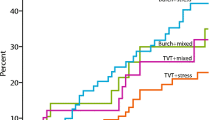Abstract:
The aim of the study was to assess the incidence of abnormal voiding in patients who had undergone tension-free vaginal tape (TVT) placement. Women who had undergone a TVT sling procedure for stress or mixed incontinence more than 3 months previously reported their voiding habits (frequency, urgency, nocturia, urinary stream quality and incontinence) over the previous 3 days. A pelvic examination and ultrasound postvoid residual (PVR) were performed. Normal voiding was classified as a PVR <100 ml, frequency of six or fewer voids per day and two or fewer per night, and a urinary stream considered normal by the patient. Subjects were classified as either ‘normal’ (group 1) or ‘abnormal’ (group 2) voiders. Demographic factors, pre-operative urodynamic testing and concomitant surgical procedures were compared between groups. From September 1999 to November 2000, 59 women underwent a TVT procedure. Two were excluded from analysis [cervical malignancy (1), interstitial cystitis (1)]. There were no healing abnormalities and no patients displayed a positive empty bladder stress test. Forty-two (74%) women were included in group 1 and 15 (26%) in group 2. Urinary continence was reported by 49 (86%): 93% in group 1 and 67% in group 2. Factors highly correlated with postoperative voiding dysfunction included abnormal preoperative uroflow pattern and configuration (P = 0.007), preoperative low peak flow rate <15 ml/s (P = 0.049), preoperative vault prolapse or enterocele (P = 0.001), concurrent vault suspension surgery (P = 0.03) and postoperative urinary tract infection (UTI) (P = 0.0006). Preoperative urinary retention (postvoid residual >100 ml) or detrusor instability, age and body mass index differences were not statistically significant. Multivariate analysis revealed that preoperative abnormal uroflow and postoperative UTI were related to group 2 (P = 0.02). Our conclusions were that the TVT sling procedure has success and voiding dysfunction rates similar to those of other proven anti-incontinence procedures. Various factors were shown to be associated with postoperative voiding difficulties. Tension-free placement of the tape may not prevent the development of post-operative voiding dysfunction.
Similar content being viewed by others
Author information
Authors and Affiliations
Additional information
Correspondence and offprint requests to: Dr G. Willy Davila, Cleveland Clinic Florida, 2950 Cleveland Clinic Blvd., Weston, Florida 33331, USA. Tel: 888–978–0004; Fax: 954–659–5560; E-mail: davilag@ccf.org
Rights and permissions
About this article
Cite this article
Wang, K., Wang, K., Neimark, M. et al. Voiding Dysfunction following TVT Procedure . Int Urogynecol J 13, 353–358 (2002). https://doi.org/10.1007/s001920200079
Issue Date:
DOI: https://doi.org/10.1007/s001920200079



